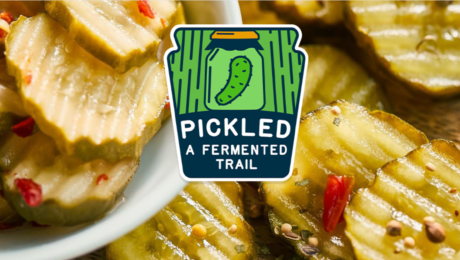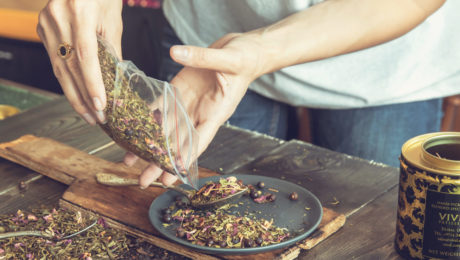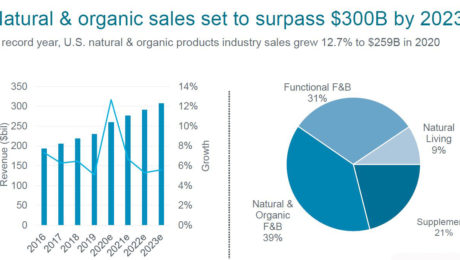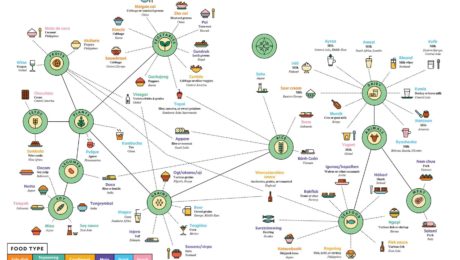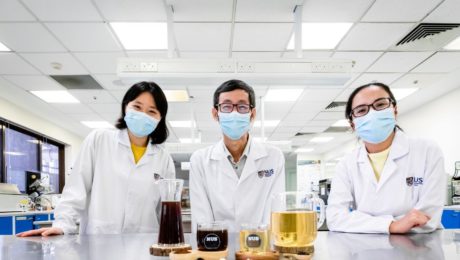Endangered Fermented Foods
Through selective breeding and domestication of plants and livestock, the world’s food system has lost diversity to an alarming degree. Crops are monocultures and animals are single species. Journalist and author Dan Saladino argues it’s vital to the health of humanity and our planet to save these traditional foods.
“There’s an incredible amount of homogenization taking place in the last century, which has resulted in a huge amount of concentration of power in the food system but also a decline in the amount of biodiversity,” says Saladino, author of Eating to Extinction. “That agricultural and biological diversity is disappearing and it’s taken us thousands, millions of years for plant, animal evolution to get to this point.”
Saladino was a keynote speaker at The Fermentation Association’s conference FERMENTATION 2022, his first in-person talk in the United States since his book was released in February. A journalist with the BBC, Saladino was also an active participant in the event, attending multiple days’ worth of educational sessions. He called the conference “mind expanding.”
“I thought I knew about fermentation, when in fact I know very little,” Saladino said to the crowd in his keynote. “We’ve been bemused by the media reports that fermentation is a fad or fashion. What we know is that the modern food system in the last 150 years is the fad. It’s barely a blip in the context of our evolution as species, and it’s the way we’ve survived as a species over thousands of years.”
Eating to Extinction includes 40 stories of endangered foods and beverages, just touching on a fraction of what is happening around the world. To date, over 5,000 endangered items from 130 different countries have been cataloged by the Slow Food Foundation’s project the Ark of Taste.
During FERMENTATION 2022, Saladino centered his remarks around the endangered fermented foods he chronicled in his book – Salers cheese, skerpikjøt, oca, O-Higu soybeans, lambic beer, pu’erh tea, qvevri wine, perry and wild forest coffee. Here are some of the highlights of his presentation.
Salers cheese (Augergne, Central France)
Fermentation was a survival strategy for many early humans, a fact especially evident in the origins of cheesemaking. In areas like Salers in central France, villagers live in inhospitable mountain areas where it’s difficult to access food. In the spring each year, cheesemakers travel up the mountains with their cattle and live like nomads for months.
“It’s extremely laborious, hard work,” Saladino says, noting there’s only a handful of Salers cheese producers left in France. He marvels at “the ingenuity of taking animals up and out to pasture in places where the energy from the sun and from the soil is creating pastures with grasses with wildflowers and herbs and so on.”
Unlike with modern cheese, no starter cultures are used to make Salers cheese. The microbial activity is provided by the environment – the pasture, the animals and even the leftover lactic acid bacteria in the milk barrels. Because of diversity, the taste is rarely consistent, ranging season to season from mild to aggressive.
“The idea of cheesemaking is a way humans expand and explore these new territories assisted by the crucial characters in this: the microbes,” he adds. “It can be argued that cheese is one of most beautiful ways to capture the landscape of food – the microbial activity in grasses, the interaction of breeds of animals that are adapted to the landscape. It’s creating something unique to that place.”
Skerpikjøt (Faroe Islands)
Skerpikjøt “is a powerful illustration to our relationship with animals, with meat eating,” Saladino says. It is fermented mutton and unique to Denmark’s Faroe Islands. Today’s farmers selectively breed their sheep for ideal wool production, then slaughter the lambs for meat. In the Faroes, “the idea of eating lamb was a relatively new concept.” Sheep are considered vital to the farm as long as they’re still producing wool and milk.
Once a sheep dies or is killed, the mutton carcass is air-dried and fermented in a shed for 9-18 months. The resulting product is “said to be anything between Parmesan and death. It certainly has got a challenging, funky fragrance,” Saldino says.
But it contrasts traditional and modern food practices. Skerpikjøt is meant to be consumed in small quantities, delicate slivers of animal proteins used as a garnish. Contemporary meat is served in large portions and meant to be consumed quickly.
Oca (Andes, Bolivia),
In the Andes – “one of the highest, coldest and toughest places on Earth to live” – humans have relied on wild plants like oca, a tuber. After oca is harvested, it’s taken to the Pelechuco River. Holes are dug on the riverbank, then filled with water, hay and muna (Andean mint). Sacks of oca are placed in the holes, weighted down by stones, and left to ferment for a month. This process is vital as it leaches out acid.
“Through processing, this becomes an amazing food,” Saladino says.
But cities are demanding certain types of potatoes, encouraging remote villagers to plant monocultures of potatoes which are prone to diseases. The farmers end up in debt, buying fertilizers and pesticides to grow potatoes.
“For thousands of years, oca and this fermentation technique and the process to make these hockey pucks of carbohydrates and energy kept them alive in that area,” Saladino says. “It’s a diversity that is fast disappearing from the Andes.”
O-Higu soybeans (Okinawa, Japan)
The modern food industry is threatening the O-Higu soybean, too. It was an ideal soybean species – fast-growing, so it can be harvested before the rainy season and the arrival of insects.
“But by the 20th century, the soy culture pretty much disappeared,” Saladino says.
With World War II came one of America’s biggest military bases to Japan. U.S. leaders dictated what food could be planted on the island. Okinawa was self-sufficient in local soy until American soy was introduced.
Lambic Beer (Belgium)
Saldino explained that, after a spring/summer harvest, Belgian farmers became brewers. They used their leftover wheat to create brews unique to the region.
But by the 1950s and 1960s, larger brewers began buying up the smaller ones. Anheuser-Busch InBev now produces one in four beers drunk around the world.
“There [is] story after story of these distinctive, unique, small breweries disappearing as they are bought up or absorbed into this growing, expanding empire of brewing,” Saladino says. “It’s probably one of the most striking cases of corporate consolidation of a drink and food product.”
Saladino stressed not all is lost. He shared stories of scientists, researchers and local people trying to save endangered foods, collecting seeds, restoring crops and combining traditional and modern-day practices to preserve the world’s rare foods.
“There have been so many fascinating stories of science and research discussed over the last few days at this conference, and I think the existence of The Fermentation Association is exciting because it is bringing together tradition, culture, science, culinary skills, all of these things we know food is,” Saladino added. “Food is economics, politics, geography, anthropology, nutrition. What I’m arguing is that these clues or glimpses into the past for these endangered foods, they’re not just some kind of a food museum or an online catalog. They are the solutions that can help us resolve some of the biggest food challenges we have.”
- Published in Food & Flavor
World’s Rarest Foods in Danger of Extinction
Journalist Dan Saladino explores the world’s endangered foods in his new book Eating to Extinction: The World’s Rarest Foods and Why We Need to Save Them. He argues that the world could lose culinary diversity. “The story of these foods, and the way in which they’re presented in the book,” says Saladino, from wild foods associated with hunters and gathers, to cereals, vegetables, meats and more, “is really the story of us and our own evolution.”
A review of Saladino’s book in Smithsonian Magazine shares 10 of the world’s rarest foods — five of them fermented. These rarities include:
- Skerpikjøt (Faroe Islands, Denmark): Dried and fermented mutton made from the shanks and legs of sheep. It ferments in wooden sheds called hjallur, which have vertical slats that allow space for the salty sea wind to blow in.
- Salers cheese (Auvergne, France): One of the world’s oldest raw milk cheeses made from the milk of Salers cows. The semi-hard cheese is made with varying fermentation lengths, which change the flavor.
- Qvevri wine (Georgia): Winemakers fill the egg-shaped terracotta pots called qvevri with grape juice, skins and stalks, then bury the pots underground. The steady temperatures and the pot’s shape allows even fermentation.
- Ancient Forest Pu-Erh Tea (Xishuangbanna, China): The fermented tea is made from wild tea leaves that grow in China’s southwestern Yunnan province. The leaves are sun-dried, cooked, kneaded, then formed into solid cakes and fermented for months (or years).
- Criollo Cacao (Cumanacoa, Venezuela): The world’s rarest type of cacao, it represents less than 5% of the cocoa production on the planet. The bean lacks bitterness, but is difficult to grow.
Read more (Smithsonian Magazine)
- Published in Food & Flavor
Fermentation Tourism
The state of Pennsylvania has created a unique tourist experience, Pickled: A Fermented Trail. The self-guided, culinary tour showcases fermented food and drink from around the state.
The fermented trail is broken into five regional itineraries, and includes historic businesses, artisanal food makers and large producers. Stops range from an Amish gift shop that ferments root beer to a master chocolatier, from a kombucha taproom to a fermentation-focused restaurant, and from a fourth-generation cheesemaker to a convenience store that makes its own pickles, sauerkraut and vinegar. Mary Miller, cultural historian and professor, spent two years designing the trail.
“Cultured foods have been part of PA’s culinary culture since the beginning,” reads the Visit Pennsylvania Pickled: A Fermented Trail website. “Many groups that have migrated to Pennsylvania throughout history were fond of fermented foods for both health and flavor, as well as for preserving food through the winter.”
The website also features a history of fermented food and drink, both regionally and globally. It shares a brief overview of root beer, which was created in Pennsylvania as a sassafras-based, yeast-fermented root tea. And it notes that, while Germans brought sauerkraut to the state, the Chinese are believed to have been the first to ferment cabbage.
The fermented trail is one of Pennsylvania’s four new culinary road trips, along with those highlighting charcuterie, apples and grains. These paths aim to showcase the state’s culinary history, and preserve its foodways.
This unique culinary adventure — the first we have seen at TFA — could be a model for tourism in other states and countries.
Read more (Food & Wine)
- Published in Business
Like the Flavor of Black Tea? Thank Fermentation
Tea connoisseurs have long believed that black tea’s flavor comes from the chemicals created during oxidation, but a new study reveals microbes at play. Black’s tea’s rich flavor is partly due to fermentation, the same microbial process used to create fermented teas like kombucha, jun and pu’erh.
What does this mean for tea producers? By adjusting the microbes on the tea leaves, fermentation could amplify the flavor in the final brewed cup of tea.
“The finding that bacterial and fungal communities also drive tea processing suggests the microbiome of the leaves can be manipulated to create greater quantities of tasty compounds due to fermentation,” says Dan Bolton, founder, editor and publisher of Tea Journey.
In research published in the Journal of Agricultural and Food Chemistry, a team of scientists from Anhui Agricultural University in China studied how sterilization of tea leaves affected tea flavor. They began by sampling the microbes on leaves from the Dongzhi tea plantation in Anhui province. Half the leaves were sterilized in mild bleach for five minutes — the other half were left untouched. All the leaves were then processed traditionally: withered, rolled, oxidized in the sun and dried.
Their conclusions found black tea produced through microbial fermentation from the unsterilized sample was full of catechins and L-theanine. Catechins are flavonoids and a naturally-occurring antioxidant; L-theanine is an amino acid (also found in mushrooms) known to ease stress and insomnia. Both compounds help make tea flavorful. The sterilized leaves produced tea that didn’t have the same amount of compounds, and so wasn’t as flavorful.
“The sterilization process dramatically decreased the content of total catechins and theanine in black tea, indicating that microbes on the surface of tea leaf may be involved in maintaining the formation of these important metabolites during black tea processing,” says Ali Inayat Mallano, PhD, professor at the university.
Interestingly, sterilization had no effect on green tea. Both samples of green tea, sterilized and unsterilized, had the same levels of caffeine and theanine.
[To explore premium dark teas, TFA recently organized a webinar Beyond Kombucha: Pu’erh, Jun and Dark Tea with Bolton and tea experts Jeff Fuchs (author, Himalayan explorer and co-founder of Jalam Teas) and Brendan McGill (chef and James Beard nominee who owns Hitchcock Restaurant Group in Seattle and Junbug Kombucha).- Published in Food & Flavor, Science
Beyond Kombucha: Pu’erh, Jun and Dark Tea
Tea consumption globally is increasing. But consumers don’t want a cheap, poor quality tea bag. They’re buying premium teas — and increasingly, dark, fermented teas.
“What’s trending right now seems to be authentic tea, tea that has great flavor, more closely married to the terroir. People are beginning to understand that it’s just fine to have tea. You don’t have to have coloring in it, you don’t have to have a lot of bits and pieces of fruit and flowers, there’s a genuine benefit to just understanding the terroir and keeping it simple,” says Dan Bolton, the founder, editor and publisher of Tea Journey. Bolton and two tea experts discussed two lesser-known fermented tea varieties in the TFA webinar Beyond Kombucha: Pu’erh, Jun and Dark Tea. “Tea just isn’t as good as it could be, without fermentation.”
A new study on tea demonstrates how important fermentation is to tea quality, Bolton says. Researchers from the Anhui Agricultural University in China recently studied the effect of surface microbiomes on the quality of black tea. The results found microbial fermentation in non-sterilized control tea samples produced complex compounds and more flavorful teas than with sterilized tea leaves. The results were published in the Journal of Agricultural and Food Chemistry.
“It’s a remarkable finding because, certainly for the last century or so, there’s been a lot of discussion about whether fermentation plays a role in the production and processing of tea,” Bolton says. The study proves “black tea is actually a result of both fermentation and oxidation.”
Pu’erh Tea
Jeff Fuchs — author, Himalayan explorer and co-founder of Jalam Teas — shared details of pu’erh tea. Pu’erh is a tea style from a strain of camellia leaf cultivated and produced in the Yunnan province. Fuchs spent over a decade living in there and is the only Westerner to have traveled the Tea Horse Road through Sichuan, Yunnan and Tibet.
“Pu’erh is a tea that certainly I think it’s been deliberately mystified to some degree,” Fuchs says. “It’s interesting that you have this very simple, raw material green tea that is now arguably one of the great boutique commodities.”
Fuchs stresses consumers need to research tea sourcing. Where is the tea coming from? How was it stored? Who stored it? Older tea cakes are being sold for large amounts of money, but can have questionable provenance.
“Young teas I think are making a big assertion in the tea world right now because they represent a closer line to the terroir, a closer line to the origin point,” he says, adding dark teas are becoming more popular in North America. He sees more bartenders experimenting with dark teas, playing with flavor compounds. “I think dark teas will come into the sway more and they’ll remain.”
Jun Tea
Jun is another tea style making waves in the fermented beverage market. It is a type of kombucha, but the base is green tea and honey instead of black tea and sugar. Brendan McGill shared his experience making jun — he is a chef and James Beard nominee; he owns the Hitchcock Restaurant Group in Seattle and the newly-launched Junbug Kombucha.
“Jun is a very special style of kombucha,” McGill says. “It’s shrouded in mystery, where these cultures originated. What we do know is how they’ve been developed and manipulated in fairly recent history. One of the joys I’ve had with this is just being extremely creative because i found that while the fermentation isn’t necessarily a delicate process, it has allowed us to modify and use a lot of different inputs that it’s actually a pretty robust fermentation process.”
McGill began making kombucha over a decade ago, as a replacement for beer and wine. He liked jun for its similar flavor to alcohol, the additional bioactive compounds that create a more nutritious drink and it’s made with honey instead of added sugar.
Junbug Kombucha uses filtered water, organic green tea, wild honey and, of course, a SCOBY. In the secondary fermentation, fresh herbs, berries and even mushrooms are added. Junbug flavors include Chaga Root Beer, Chili Raspberry and Maui Mana.
- Published in Business, Food & Flavor
State of the Natural & Organic Industry
The Covid-19 pandemic powered strong food and beverage sales last year. But natural and organic brands grew even faster than conventional ones, with sales growing 12.7% to $259 billion.
“Natural products throughout the last year have really been outpacing all product growth. Natural and clean products are now about $1 out of every $10 spent, which is really significant,” says Kathryn Peters, executive vice president of SPINS, a retail data provider. Peters presented sales trends at the virtual Natural Products Expo West.
Data from SPINS and Nutrition Business Journal documents that there was a “dramatic shift” in consumer behavior during the pandemic, as more people cooked at home and bought healthier foods.
“2020 was a record year for the U.S. natural and organic product industry,” says Carlotta Mast, senior vice president and market leader for New Hope Network, producers of the Natural Products Expos. “The industry has so much to celebrate, despite the very challenging time we’ve been through the past 14 months.”
Natural and organic sales are expected to pass the $300 billion mark by 2023.
Food as Medicine
Functional food and beverage sales grew 9.4% to $78 billion in 2020, a surprisingly high figure since grab-n-go offerings — the category in which many functional products are tracked — were reduced significantly during the pandemic.
“And yet that strong growth, nearly 10% experienced in that category, demonstrates that people continue to embrace the food as medicine trend,” Mast says.
Products that claim to offer immune-boosting, functional ingredients are selling well. Consumers are “shifting from reactive to preventative and from cold and flu season to year-round protection.” Ingredients and supplements like elderberry, vitamins C and D, antioxidants, collagen and cider vinegar are increasing in sales.
Sales of animal welfare-positioned products grew 17% in 2020, and sales of grass-fed and free-range products increased more than 13%. Other key wellness attributes that appeared to drive significant dollar growth included paleo (up 32%), plant-based (21%) and grain-free (18%).
“Consumers are expecting more from the products they buy,” Peters said. “Whether it’s because of a limited budget or health and wellness considerations to build a stronger body, people are seeking nutritional benefits.”
Mission-Driven
Consumers are seeking to buy from brands with a purpose. These are products that, for example, want to save the environment, create a sustainable food system, champion a social justice cause or support a minority group.
Nick McCoy, co-founder and managing director at Whipstitch Capital, a food-focused investment bank, calls these brands “better for people and the planet” and says they are “doing good while making money at the same time.” The amount of ESG (Environmental Social Governance) investment funds has increased tenfold over the past two years.
Brands that are mission- and community-minded are experiencing the strongest sales growth.
“This demonstrates that our industry is home to brands that do a lot more than just sell a product — they’re a force for better, better health and better outcomes for humans, animals and the environment,” Mast says. “Our industry shoppers expect more than a transaction from the brands they do business with.”
In a SPINS survey, consumers said they want to support brands that are LGBTQ owned (19%), BIPOC owned (28%) and/or woman owned (18%).
Vegetarian and vegan products are also increasing in sales. Plant-based and meat alternatives grew 21% last year, at a rate of two-times their mainstream counterparts.
“In many cases, plant-based is bringing more nutrient density than the original animal-based analog,” Peters says . “Plant-based support is growing beyond just health benefits to earth-based benefits like lower greenhouse gas emissions, water conservation and biodiversity.”
E-Commerce
Not surprisingly, e-commerce sales fast-tracked during the pandemic, accounting for 58% of natural and organic sales last year. E-commerce also became the main channel where new brands were launched. Though sales in brick-and-mortar stores are not predicted to return to pre-pandemic levels, physical retail locations are still expected to account for 30% of all natural and organic products sales in 2023.
Speakers at the event advised brands to take an omnichannel approach, tackling marketing through brick-and-mortar stores as well as e-commerce channels. Sashee Chandran, founder and CEO of Tea Drops (a producer of organic tea pressed and preserved in different shapes), spoke at the conference about her experience following this marketing approach.
“Even though things are opening up, consumers still want that flexibility to be able to shop online but also in store,” she says.
- Published in Business
The World of Fermented Foods
In the latest issue of Popular Science, a creative infographic illustrates “the wonderful world of fermented foods on one delicious chart.” It represents “a sampling of the treats our species brines, brews, cures, and cultures around the world,” and is particularly interesting as it shows mainstream media catching on to fermentation’s renaissance. Fermentation fit with the issue’s theme of transformation in the wake of the pandemic.
Read more (Popular Science)
- Published in Food & Flavor
New Fermented Coffee & Tea Drinks
Researchers from the National University of Singapore (NUS) have created new fermented coffee and tea drinks. These drinks, invented by a professor and two doctoral students, are being labeled as “probiotic coffee and tea drinks that are packed with gut-friendly live probiotics.” They claim that the drinks can be stored for three months without altering the probiotics.
“Coffee and tea are two of the most popular drinks around the world, and are both plant-based infusions. As such, they act as a perfect vehicle for carrying and delivering probiotics to consumers. Most commercially available probiotic coffee and tea drinks are unfermented. Our team has created a new range of these beverages using the fermentation process as it produces healthy compounds that improve nutrient digestibility while retaining the health benefits associated with coffee and tea,” explained NUS Associate Professor Liu Shao Quan.
Read more (Science Daily)



